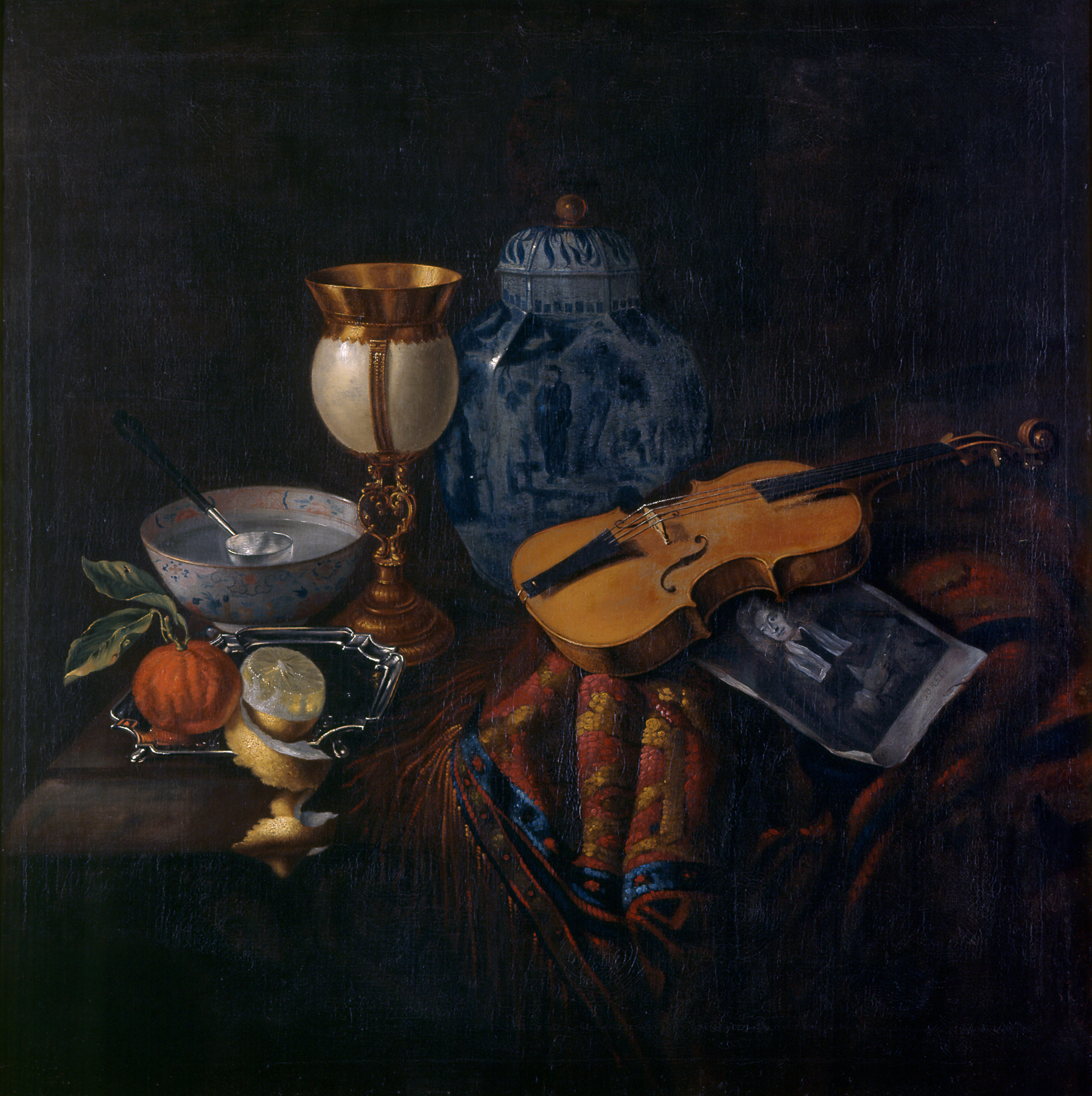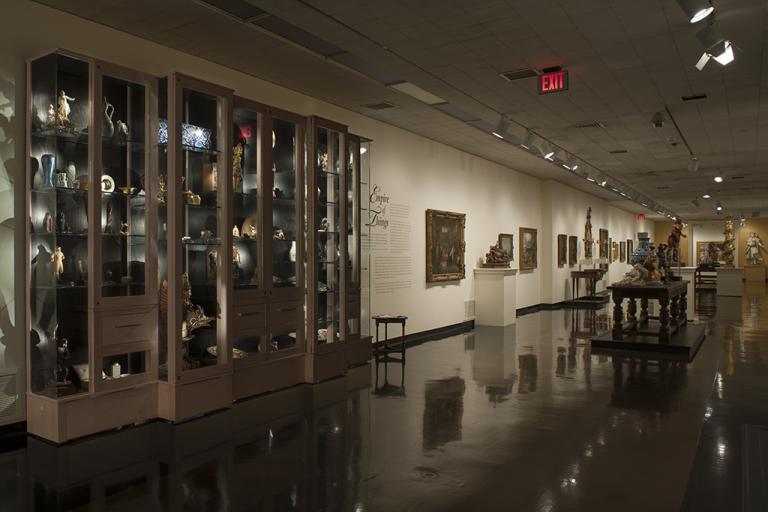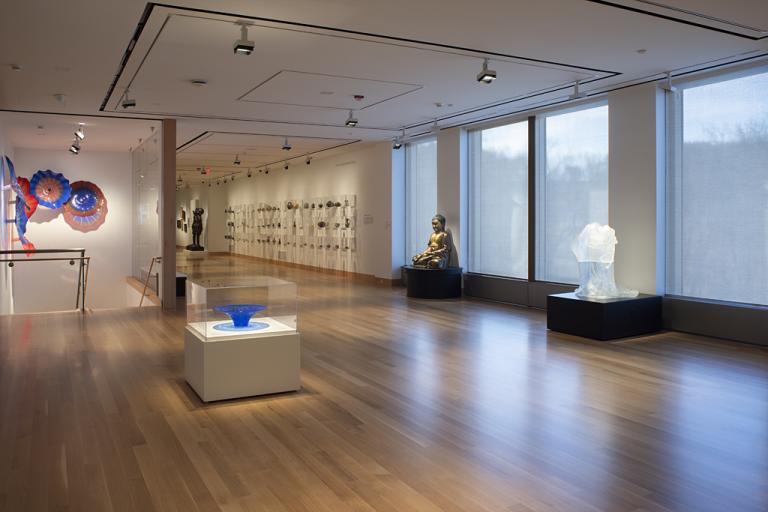Still Life with Violin and Engraving of Arcangelo Corelli, Dutch School
Artwork Overview
Canvas/Support (Height x Width x Depth): 120 x 119.8 cm
Canvas/Support (Height x Width x Depth): 47 1/4 x 47 3/16 in
Frame Dimensions (Height x Width x Depth): 47 x 46 3/4 x 3 in
If you wish to reproduce this image, please submit an image request
Images
Label texts
Light illuminates an arrangement of objects that includes a drinking cup fashioned from an ostrich egg, a blue and white porcelain jar, and imported citrus fruits on a silver tray. These luxury goods became available to Dutch middle- and upper-class consumers as a result of Dutch colonialism and trade power. While this painting celebrates the acquisition of these goods, it ignores the human suffering of the transatlantic slave trade that was intrinsically linked to their availability.
Light illuminates an arrangement of objects that includes a drinking cup fashioned from an ostrich egg, a blue and white porcelain jar, and imported citrus fruits on a silver tray. These luxury goods became available to Dutch middle- and upper-class consumers as a result of Dutch colonialism and trade power. While this painting celebrates the acquisition of these goods, it ignores the human suffering of the transatlantic slave trade that was intrinsically linked to their availability.
Bright light illuminates an arrangement of objects that includes a fanciful drinking cup fashioned from an ostrich egg and a large lidded jar. The lemon peel, dangling in a spiral over the edge of a silver salver, reveals glistening flesh that appeals simultaneously to the viewer’s taste and sight. The engagement of the senses continues with the violin. An engraving of Arcangelo Corelli, a celebrated Italian composer and violinist, evokes the experience of hearing a performance of Corelli’s compositions.
Bright light illuminates an arrangement of objects that includes a fanciful drinking cup fashioned from an ostrich egg and a large lidded jar. The lemon peel, dangling in a spiral over the edge of a silver salver, reveals glistening flesh that appeals simultaneously to the viewer’s taste and sight. The engagement of the senses continues with the violin. An engraving of Arcangelo Corelli, a celebrated Italian composer and violinist, evokes the experience of hearing a performance of Corelli’s compositions.
Click on the audio tab above to listen to a student's interpretation of this object.
Bright light illuminates an arrangement of objects that includes a fanciful drinking cup fashioned from an ostrich egg and a large lidded jar. Imported to the Netherlands from China, porcelain vessels were precious commodities, prized for their delicacy and beauty. The popularity of these ceramics led to the domestic production of imitations, which later developed into Dutch blue and white Delftware. Likewise, the orange and lemon would have appeared on the Netherlandish table only after transport from the sunny Mediterranean climate. The lemon peel, dangling in a spiral over the edge of a silver salver, reveals glistening flesh that appeals simultaneously to the viewer’s taste and sight. The engagement of the senses continues with the violin that occupies the center of the composition. Paired with an engraving of Arcangelo Corelli, a celebrated Italian composer and violinist, the instrument evokes the experience of hearing a performance of Corelli’s compositions.
Bright light illuminates an arrangement of objects that includes a fanciful drinking cup fashioned from an ostrich egg and a large lidded jar. Imported to the Netherlands from China, porcelain vessels were precious commodities, prized for their delicacy and beauty. The popularity of these ceramics led to the domestic production of imitations, which later developed into Dutch blue and white Delftware. Likewise, the orange and lemon would have appeared on the Netherlandish table only after transport from the sunny Mediterranean climate. The lemon peel, dangling in a spiral over the edge of a silver salver, reveals glistening flesh that appeals simultaneously to the viewer’s taste and sight. The engagement of the senses continues with the violin that occupies the center of the composition. Paired with an engraving of Arcangelo Corelli, a celebrated Italian composer and violinist, the instrument evokes the experience of hearing a performance of Corelli’s compositions.
Exhibition Label:
"Empire of Things," 2013, Kate Meyer
Bright light illuminates an arrangement of objects that includes a fanciful drinking cup fashioned from an ostrich egg and a large lidded jar. Imported to the Netherlands from China, porcelain vessels were precious commodities, prized for their delicacy and beauty. The popularity of these ceramics led to
the domestic production of imitations, which later developed into Dutch blue and white Delftware. Likewise, the orange and lemon would have appeared on the Netherlandish table only after transport from the sunny Mediterranean climate. The lemon peel, dangling in a spiral over the edge of a silver salver, reveals the glistening flesh that appeals simultaneously to the viewer’s taste and
sight. The engagement of the senses continues
with the violin that occupies the center of the composition. Paired with an engraving of Arcangelo Corelli, a celebrated Italian composer and violinist, the instrument evokes the experience of hearing a performance of Corelli’s compositions.










